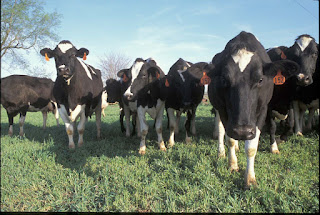 | Because much of the cost of a cow is the feed and labor needed to maintain her, fewer but higher yielding cows mean lower priced milk. Dairy herd improvement ultimately benefits consumers. |
The results of years and years of scientific dairying? Milk production has been trending upward for more than 25 years in the United States-from about 117,000 million pounds in 1970 to more than 150,000 million pounds in 1994-even though the number of milk cows has been reduced. Photo by Keith Weller.
Dairy cattle From Wikipedia, the free encyclopedia
A young dairy animal is known as a calf. A female calf which has not given birth to a calf and is less than thirty months old is called a heifer. When the heifer is seven months pregnant or has reached the stage in pregnancy where the udder starts to swell, it is known as a springer. After calving, or when more than thirty months old, a female dairy animal is known as a cow.
The process of birthing a calf is known as calving or parturition. A male dairy animal is called a bull at any stage of life, unless castrated, in which case it is known as a steer until it is four years old, then it is called an ox. A dairy animal's mother is known as its dam. Similarly, a dairy animal's father is known as its sire.
This article is licensed under the GNU Free Documentation License. It uses material from the Wikipedia article, Dairy cattle
Digital Rights and Copyright: Most information presented on the USDA Web site is considered public domain information. Public domain information may be freely distributed or copied, but use of appropriate byline/photo/image credits is requested. Attribution may be cited as follows: "U. S. Department of Agriculture."
The NRCS Photo Gallery contains natural resource and conservation related photos. You are free to use these photos in publications, on a web site or as a part of any other project. These photos may not be used to infer or imply NRCS endorsement of any product, company, or position.
Generally speaking, works created by U.S. Government employees are not eligible for copyright protection in the United States. See Circular 1 "COPYRIGHT BASICS" from the U.S. Copyright Office.
Technorati tags: Public Domain Clip Art and clip art or public domain and Dairy Cows or Bos taurus and Holstein or Ronald Reagan "A Time for Choosing" 10/27/64 VIDEO PODCAST and Pigs Sus scrofa or S. domesticus and FDA Nanotechnology Report Outlines Scientific, Regulatory Challenges













No comments:
Post a Comment